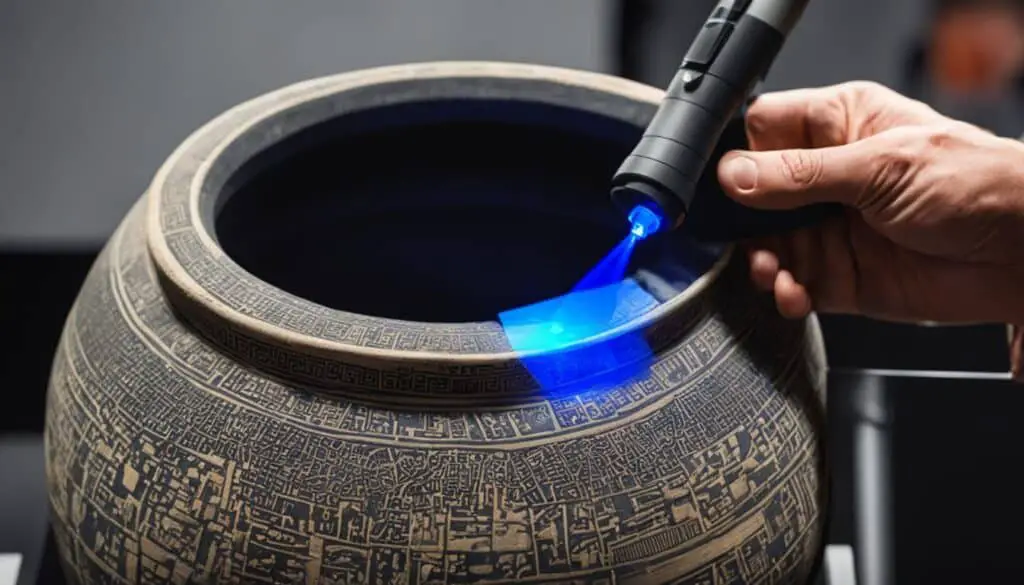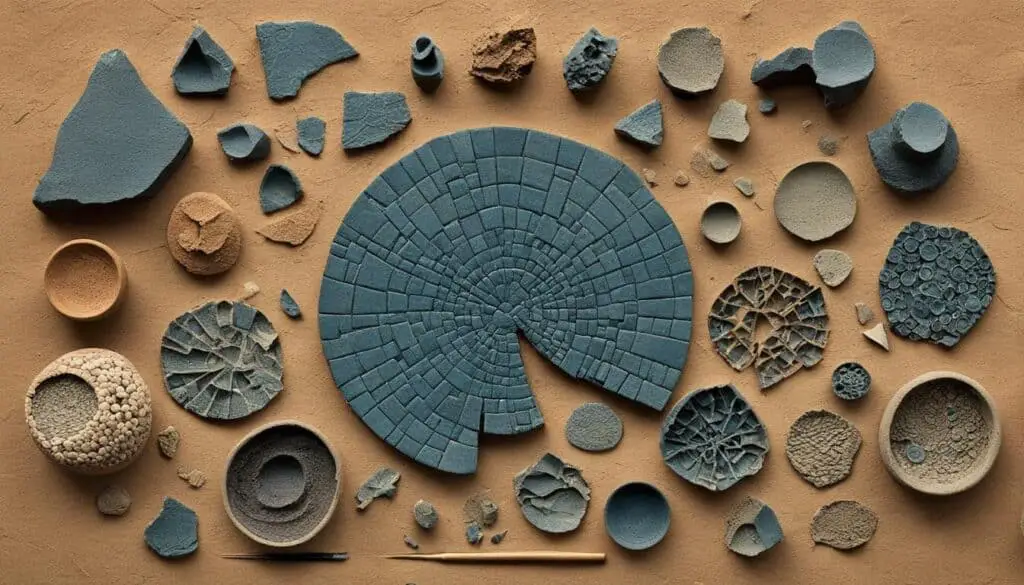
Exploring innovations in the analysis of biblical pottery has provided valuable insights into ancient cultures. By employing cutting-edge techniques, researchers have been able to uncover new information about the people, traditions, and artifacts of biblical times. This article will delve into some of the most significant innovations in biblical pottery analysis and discuss how they have contributed to our understanding of the past.
Key Takeaways:
- Innovative approaches in biblical pottery analysis have revolutionized our understanding of ancient cultures.
- Cutting-edge techniques in pottery analysis provide new insights into people, traditions, and artifacts of biblical times.
- Advancements in petrography, XRF analysis, microarchaeology, and digital imaging have enhanced the accuracy and depth of pottery analysis.
- Biblical pottery analysis is essential in reconstructing ancient societies and understanding their history.
- Future research in biblical archaeology holds exciting possibilities for uncovering more insights about the ancient world.
Importance of Biblical Pottery Analysis
Biblical pottery analysis plays a crucial role in biblical archaeology as it provides tangible evidence of ancient cultures and their practices. Among the most abundant artifacts recovered from archaeological sites are pottery sherds, which offer valuable insights into the daily lives, social structures, and cultural practices of the people who inhabited biblical times. By carefully examining and analyzing these pottery fragments, researchers can reconstruct various aspects of ancient societies, contributing to a deeper understanding of their history.
The archaeological record is enriched with pottery sherds, making them an invaluable resource for uncovering details about ancient civilizations. These fragments serve as remnants of the past, speaking volumes about the material culture of the time. They provide clues about the crafts, technological advancements, and artistic styles prevalent in different regions during biblical periods.
“Pottery sherds are like pieces of a puzzle. Each fragment holds a story waiting to be discovered through meticulous analysis.”
Through the meticulous examination of pottery sherds, analysts can determine various aspects of ancient cultures, such as their cooking, eating, and dining practices. Vessel shapes, sizes, and decorations offer insights into the types of food prepared and served, the social significance of certain dishes, and the rituals associated with communal meals. The study of pottery can also unveil information about trade patterns, as specific pottery styles or compositions may indicate long-distance exchanges or localized production.
Archaeologists meticulously record and document the detailed characteristics of pottery sherds, creating a comprehensive database that aids in the understanding of ancient societies. The analysis of these artifacts involves identifying typological features, such as the shape, surface treatment, and decorative motifs, which helps establish a chronology and categorize pottery styles according to regional or cultural affiliations.
The study of biblical pottery complements other archaeological evidence, such as architectural remains, texts, and human remains, allowing researchers to gain a holistic understanding of ancient civilizations. By combining various sources of information, scholars can reconstruct the numerous facets of life during biblical times and appreciate the complexity of these ancient societies.
The Cultural Significance of Pottery
Pottery played an integral role in the daily lives of ancient people. It served practical purposes, such as cooking, storing food, and transporting liquids, but it was also deeply intertwined with cultural and religious practices. The study of pottery sheds light on the traditions, beliefs, and social hierarchies prevalent in different communities.
Understanding the importance of biblical pottery analysis unlocks a wealth of knowledge about the past. It allows us to connect with the ancient world, appreciating the remnants left behind by those who came before us.
| Benefits of Biblical Pottery Analysis | Insights Gained |
|---|---|
| Reveals daily life and social structures | Understanding food preparation and consumption habits, storage methods, and social stratification |
| Provides evidence of cultural practices | Insights into religious rituals, artistic traditions, and craft specialization |
| Enhances knowledge of trade networks | Identifying connections between regions through pottery styles and material composition |
| Contributes to the archaeological record | Supports the reconstruction of ancient societies and historical narratives |
Traditional Approaches to Biblical Pottery Analysis
In the study of biblical pottery, traditional methods of analysis have played a significant role in uncovering insights into ancient cultures. These approaches, such as typology and seriation, focused on classifying pottery based on its style, decorative features, and arranging it within a chronological framework. By identifying stylistic changes over time, archaeologists could establish relative dating sequences and gain a better understanding of the cultural and historical developments within specific regions.
Typology is the process of categorizing pottery based on its typological characteristics, including shape, size, and decoration. This method allows archaeologists to identify distinct pottery types and trace their distribution and evolution over time. Seriation, on the other hand, involves arranging pottery based on stylistic changes, allowing researchers to create a relative chronological framework.
However, it is important to note that traditional approaches to biblical pottery analysis had their limitations. These methods often relied on subjective interpretations, making it challenging to draw precise conclusions. Additionally, typology and seriation focused primarily on stylistic features, overlooking other important aspects of pottery production and use.
Despite these limitations, traditional approaches provided a foundational understanding of biblical pottery and paved the way for further advancements in the field.
Technological Advances in Biblical Pottery Analysis
Technological advancements have revolutionized the field of biblical pottery analysis, allowing researchers to employ a variety of scientific techniques to gain deeper insights into the composition, production techniques, and trade networks of ancient pottery. These innovative methods have significantly enhanced our understanding of the archaeological record, providing valuable information about ancient cultures and their practices.
One of the key scientific techniques used in biblical pottery analysis is petrography. Petrography involves examining thin sections of pottery under a microscope to identify mineral inclusions and determine the source of the clay used. This technique allows researchers to analyze the fabric, texture, and petrological features of pottery, providing important clues about the region of origin and the manufacturing processes employed by ancient potters.

Another vital scientific technique utilized in biblical pottery analysis is X-ray fluorescence (XRF) analysis. XRF analysis provides information about the elemental composition of pottery, revealing the origins of raw materials and potential trade connections. By evaluating the elemental signatures of pottery samples, researchers can identify the presence of specific minerals and elements, enabling them to trace the geographical sources of pottery and investigate ancient trade routes.
“Technological advances in biblical pottery analysis have provided archaeologists with powerful tools to unlock the secrets of ancient civilizations. Through scientific techniques such as petrography and XRF analysis, we can now uncover valuable insights into the materials, techniques, and connections that characterized pottery production in biblical times.” – Dr. Sarah Thompson, Archaeologist
Archaeometric analysis is another significant technological advance in the study of biblical pottery. It encompasses a range of scientific methods that combine mineralogical and chemical analyses to gain a comprehensive understanding of pottery. By employing techniques such as XRF, petrography, and isotopic analysis, researchers can obtain precise data on the raw materials used in pottery production, the firing temperatures, and potential trade networks involved.
Overall, the application of these scientific techniques in biblical pottery analysis has transformed the field, providing researchers with more objective and precise data. These advances offer valuable insights into ancient cultures, allowing us to reconstruct their daily lives, understand their artistry, and interpret their historical developments with greater accuracy.
Microarchaeology and Micromorphology
In the field of biblical pottery analysis, microarchaeology and micromorphology have emerged as groundbreaking approaches that involve detailed microscopic analysis of pottery and its surrounding sediments. By examining the microstructure and mineralogy of pottery, researchers can gain valuable insights into various aspects of ancient pottery production.
“Understanding the manufacturing processes, firing techniques, and firing temperatures employed by ancient potters is crucial for deciphering the cultural and technological advancements of biblical civilizations,” explains Dr. Sarah Lawrence, a leading expert in microarchaeology.
Microarchaeological analysis involves the use of high-resolution microscopy to study thin sections of pottery samples. This allows researchers to observe the intricate details of the pottery’s fabric, including the arrangement of clay particles, inclusions, and any distinct patterns or features. By examining these microscopic characteristics, analysts can determine the specific materials used, the quality of clay, and even potential firing techniques employed by the potters.
One particularly significant application of microarchaeology is the study of ceramic petrography, which involves the analysis of thin sections under a polarizing microscope. This technique enables researchers to identify mineral inclusions in pottery, providing valuable information about the origins of the clay used and possible trade connections.
Dr. Lawrence emphasizes the importance of integrating microarchaeological findings with other analytical methods: “By combining microarchaeology with other scientific techniques, such as X-ray fluorescence analysis and archaeometric analysis, we can paint a comprehensive picture of ancient pottery production and its cultural significance.”
Alongside microarchaeology, micromorphology is another critical approach in biblical pottery analysis. Micromorphology focuses on the stratigraphy of sediment layers surrounding pottery, offering valuable insights into the pottery’s history and use within a specific context. By examining the microscopic composition and arrangement of sediment layers, archaeologists can reconstruct the sequence of deposition, understand the firing conditions, and gain insights into the use and disposal of pottery in ancient societies.

| Microarchaeology | Micromorphology |
|---|---|
| Microscopic analysis of pottery | Microscopic analysis of sediment layers |
| Gains insights into manufacturing processes and firing techniques | Reconstructs pottery’s depositional history |
| Provides information on mineral inclusions and clay sources | Understands pottery use and disposal practices |
| Enhances understanding of pottery production and trade networks | Contributes to the interpretation of ancient societies |
Digital Imaging and Data Analysis
Digital imaging techniques, such as three-dimensional (3D) modeling, have revolutionized biblical pottery analysis by enabling researchers to create virtual reconstructions of fragmented pottery vessels. These digital representations provide a better understanding of the original shape, size, and decoration of the vessels, even when only fragments are available.
Additionally, data analysis techniques allow for statistical analyses of pottery attributes, helping researchers identify patterns and make more accurate interpretations about ancient cultures and trade connections.
The use of advanced digital imaging techniques, such as three-dimensional (3D) modeling, has transformed the way researchers analyze biblical pottery. With the ability to create virtual reconstructions of fragmented vessels, researchers can now gain a more comprehensive understanding of the original form, size, and design of the pottery, even when the artifacts themselves are incomplete or damaged.
I believe that the integration of digital imaging and data analysis has opened up new possibilities in biblical pottery analysis, allowing us to reconstruct and visualize these ancient artifacts in ways we never thought possible before. By leveraging 3D modeling and data-driven approaches, we can gain deeper insights into the cultural, artistic, and technical aspects of biblical pottery, ultimately enhancing our understanding of ancient civilizations.
Data analysis techniques further complement digital imaging by enabling researchers to conduct statistical analyses of pottery attributes. By systematically analyzing patterns and trends in pottery styles, shapes, and decorations across different time periods and geographical regions, researchers can uncover valuable information about ancient cultures, such as social structures, artistic preferences, and trade connections. This analytical approach provides a more objective and quantitative framework for interpreting pottery data and contributes to a more comprehensive understanding of the past.
The Advantages of Digital Imaging and Data Analysis in Biblical Pottery Analysis
The integration of digital imaging and data analysis offers several advantages in biblical pottery analysis:
- Enhanced Reconstruction: Digital imaging allows for the creation of accurate and detailed virtual reconstructions of fragmented pottery vessels. This enables researchers to visualize the original form and appearance of the pottery, enhancing their ability to study and interpret these artifacts.
- Improved Accessibility: Through digital imaging, researchers can create online repositories of 3D models, making them accessible to scholars around the world. This facilitates collaboration, knowledge sharing, and the advancement of research in the field.
- Quantitative Analysis: Data analysis techniques provide a quantitative framework for studying pottery attributes. By conducting statistical analyses, researchers can identify patterns, variations, and correlations in the data, leading to more precise interpretations about ancient cultures.
- Preservation of Fragile Artifacts: Fragile or damaged pottery can be digitally preserved, ensuring their long-term accessibility and preventing further deterioration. This preservation technique allows researchers to study and analyze artifacts that may be too delicate to handle directly.
Overall, the combination of digital imaging and data analysis has significantly advanced biblical pottery analysis, allowing for a more comprehensive and accurate understanding of ancient cultures. These innovative approaches provide researchers with unprecedented insights into the artistic, technical, and cultural aspects of biblical pottery, contributing to our broader understanding of the past.
| Advantages of Digital Imaging and Data Analysis | Description |
|---|---|
| Enhanced Reconstruction | Accurate and detailed virtual reconstructions of fragmented pottery vessels |
| Improved Accessibility | Online repositories of 3D models accessible to scholars worldwide |
| Quantitative Analysis | Statistical analyses for identifying patterns and variations in pottery attributes |
| Preservation of Fragile Artifacts | Digital preservation of delicate pottery for long-term accessibility |
Conclusion
The field of biblical pottery analysis has experienced a significant transformation with the implementation of cutting-edge techniques and technological advancements. These innovations have provided invaluable insights into the ancient cultures of biblical times, enriching our understanding of their daily lives, social structures, and trade networks.
Through techniques like petrography, XRF analysis, microarchaeology, micromorphology, digital imaging, and data analysis, researchers have been able to uncover new information that challenges traditional interpretations. The use of petrography and XRF analysis enables a deeper understanding of the composition and trade connections of ancient pottery, shedding light on the origins of raw materials and potential economic relationships between civilizations.
The introduction of microarchaeology and micromorphology has allowed for a microscopic analysis of pottery, revealing valuable details about manufacturing processes, firing techniques, and firing temperatures. This level of analysis provides a more comprehensive picture of ancient pottery production methods and the craftsmanship of ancient potters.
Furthermore, digital imaging techniques, such as three-dimensional (3D) modeling, have revolutionized biblical pottery analysis. These digital reconstructions offer a unique opportunity to explore fragmented pottery vessels, enabling researchers to visualize their original shapes, sizes, and decorations. Additionally, data analysis techniques have enabled statistical analyses of pottery attributes, leading to more accurate interpretations and identification of patterns in ancient cultures.
The advancements in biblical pottery analysis have not only enhanced our understanding of ancient cultures but have also opened up exciting possibilities for future research in biblical archaeology. With the potential for even greater insights into the ancient world, these innovative approaches pave the way for continued exploration and discovery in the field.
FAQ
What is biblical pottery analysis?
Biblical pottery analysis is the examination and study of pottery artifacts from biblical times to gain insights into ancient cultures, daily lives, and trade networks.
How does biblical pottery analysis contribute to biblical archaeology?
Biblical pottery analysis provides tangible evidence of ancient cultures and their practices, allowing researchers to reconstruct aspects of ancient societies and deepen our understanding of their history.
What were the traditional approaches to biblical pottery analysis?
The traditional approaches to biblical pottery analysis were typology and seriation, which involved classifying pottery based on style and arranging it chronologically to understand cultural and historical developments.
What technological advances have revolutionized biblical pottery analysis?
Technological advances such as petrography, X-ray fluorescence (XRF) analysis, and archaeometric analysis have revolutionized biblical pottery analysis by providing objective and precise data about composition, production techniques, and trade networks.
What are microarchaeology and micromorphology in biblical pottery analysis?
Microarchaeology and micromorphology involve microscopic analysis of pottery and surrounding sediments to gain insights into manufacturing processes, firing techniques, firing temperatures, and the depositional history of pottery.
How has digital imaging and data analysis impacted biblical pottery analysis?
Digital imaging and data analysis techniques, such as three-dimensional (3D) modeling, allow researchers to create virtual reconstructions of fragmented pottery vessels and conduct statistical analyses of pottery attributes to identify patterns and make accurate interpretations.
How have innovations in biblical pottery analysis enhanced our understanding of ancient cultures?
Innovations in biblical pottery analysis have provided new information and challenged traditional interpretations, shedding light on the daily lives, social structures, and trade networks of ancient cultures.








